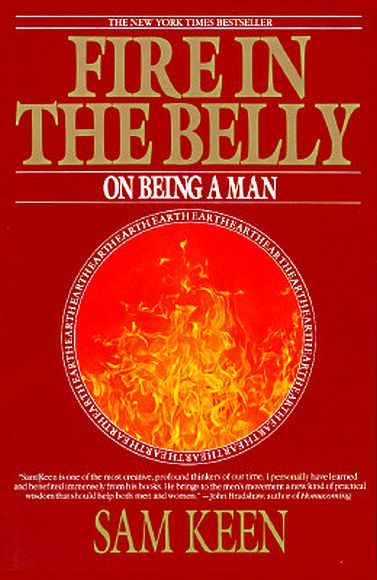

| FIRE IN THE BELLY: On Being a Man Sam Keen New York: Bantam Books, 1991 |
Rating: 5.0 High |
|||
| ISBN-13 978-0-55307-188-7 | ||||
| ISBN 0-55307-188-2 | 272pp. | SC | $19.95 | |
After the feminist movement of the 1960s and 70s, there arose a backlash of sorts. It spawned a spate of books protesting the feminist doctrine (really from the radical fringe of feminism) that the basic attitudes all men possess were the problem. Sam Keen's book is one of the better of these.
It is a highly personal account, and Keen illustrates his thesis with incidents drawn from his own life. That thesis is that both men and women have been deranged — souls misshapen, lives bereft of true passion — by the cultural forces of Western civilization. He comes across as a liberal with Marxist leanings in some places; but I believe there is much merit in his argument.
The book first explores the all-pervasive influence of women — idealized as the archetype WOMAN — on the life of any man. As Goddess and creatrix, Mother and matrix, erotic-spiritual power, WOMAN underlies the formation of his multi-layered manhood like magma underlies the stratified surface of the Earth. Only by finally recognizing and discarding this mythical WOMAN, Keen argues, can he free himself to see and love the real women in his life as they are.
Keen then considers various rites of passage that men undergo. Central to this discussion is a triad of factors: war, work and sex. According to him, they reinforce the growth of men into the stereotypical macho man, imprisoning them in a strait-jacket of performance anxiety. Men must control themselves in order to kill the enemy, corner the market, conquer the mate. They lose a part of their true nature as a result. Here, he sounds a little like Warren Farrell. But, unlike Farrell, he points out that the cultural pressures also harm women. If men become too active, too dominating, women are made too submissive. And, although Keen proclaims the worth of appropriate outrage, his book has less of an undertone of outrage against the extremes of feminism than Farrell's.1
The solution, Keen contends, is for the future to deliver. We are, in his view, living through a time of turmoil; several kinds of revolution are under way, and the shape of manhood (or womanhood) that will emerge when things settle down can only be glimpsed. But he offers some hints. The hero of tradition stood alone, exemplifying the warrior virtues: prowess in combat; stoical acceptance of pain, discomfort and solitude; prideful exaltation of self above all others; unfailing projection of an attitude of certitude and mastery. In contrast, the hero of the future will choose cooperation first, and respect others who cooperate with him; will recognize his deep need for friendship and community; will be humble, as befits a being who sees himself as one strand in the web of life, not the pinnacle of creation; will tolerate uncertainty, for he understands that life is an unfathomable mystery, unfolding in a cosmos of unimaginable vastness.
It would be easy, for someone steeped in traditional macho manhood, to belittle this as touchy-feely, tree-hugging wimpiness. The opposite is the case. With so much unknown and unknowable, what is true and certain becomes that much more valuable: genuine emotions; individual ethics and beliefs; families and friendships; truths religious, practical and scientific; and even a touch of wild ferocity. In such a world as Keen contemplates, men are more likely to hold to their own course than in present Western capitalist culture, which so often treats people as interchangeable cogs having value only insofar as they are "team players" who obey orders and slavishly contribute to the "bottom line". Yes, his book is a revolutionary tract. But the revolution it advocates is only that revolution which takes place in every generation, often unnoticed: The German soldier refusing to fire on unarmed civilians and taking his place with them to be mowed down by his former comrades; Lenny Skolnik leaping into icy Potomac water to save a stewardess; Goodman, Schwerner and Chaney stepping into the fire in order to advance the cause of racial integration; the Berrigan brothers spending a lifetime on the barricades to further the cause of peace; Martin Luther King defying an entire nation and its president in the service of both those causes; Carl Sagan standing foursquare against a rising tide of ignorance and superstition. I could fill many pages with names known to — and from — the current generation alone, and still I would not have come close to naming them all.
Indeed, it is a revolutionary tract — for a revolution that will not be televised. And it is a book to be swallowed in small bites, for it reaches deep into the shadowy chasms of the self where there be dragons and demons. Not as ego-shaking as Robert Pirsig's Zen and the Art of Motorcycle Maintenance, it nevertheless challenges us to let go of much that we hold dear and dependable in our emotional lives. We will be the better for the journey, for, as Keen says, there are truths best learned facing a storm at sea in a small boat.
The book has some faults: a few grammatical errors (mostly cases of putting articles like "a" and "the" where they don't belong, or omitting them where they do); a reference to men as interchangeable "clogs" (I think he meant cogs); and one outright goof [page 203] — it was Rosa Parks, not Rosa Banks, who refused to sit in the back of that bus.

 To contact Chris Winter, send email to this address.
To contact Chris Winter, send email to this address.